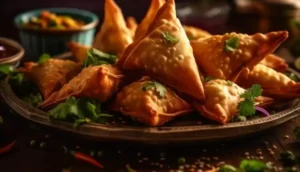Mastering the Art of Making Sambusa at Home

The tantalizing flavors of East African cuisine are just a few clicks away If you are interested, feel free to join me. For instance, sambuca, it’s a delicious pastry made of spices and other miscellaneous stuff that make it more suited for a rebound. We’ll show you how to create these delightful delights in your very own home with this great guide. From choosing the right spices to even the way of wrapping the triangles, making sambusa recipe at home is easier than ever, and soon you will be able to cook them at home for your beloved families and friends. Here, our beloved East African cuisine takes over and is ready to help you become a pro-home cook. I have 20 years of experience in cooking. So you can trust me.
What are Sambusas? An Introduction to the Popular Somali Snack
Sambusas or samosaurs in other regions of the world, is a tasty appetizer and Somali street food that has won the palate of the many food lovers and gourmets. Pyramidal in shape, these come with a flavorful filling including meat, vegetables, or both, and deep fry until crispy. The end product is a crispily fried outside covering that offers a squeezing and aromatic stuffing.
Origins and Cultural Significance
Sambusas were introduced to Somali cuisine from the Middle East, and South Asia by way of business and contacts. Now they are typical Somali dishes, especially during the fasting period (Ramadan), weddings, or any other ceremonies. These have spread widely over the region and can be found in most of the eastern African countries and among the Somali diaspora.
Variations and Fillings
Although the most traditional Somali sambusa is a pastry pocket triangular in shape, filled with spiced ground meat, onions, and aromatic herbs, there are numerous derivates of this snack depending on people’s preferences. Possible vegetables that can be eaten are lentils, potatoes, or a combination of vegetables. The filling is then enhanced by spices such as cumin, coriander, and pepper to come out with that special Arabic sambusa recipe taste.
Sambusa Dough: The Secret to Flaky, Tender Pastry

The Perfect Flour Mix
When it comes to ambush everything begins with dough. To attain that ideal, of flakiness, begin by combining all-purpose and whole wheat flour. This mix gives the baking banana structure plus adds a thread of nuttiness to the pastry. For best results, use a ratio of 3:1 all-purpose flour to whole wheat flour.
Balancing Moisture and Fat
When doing so it is necessary to add water and oil in order to achieve a dough that is both delicate and flexible. The water on its part brings out the gluten in the flour and the oil on its part moistens the dough and contributes to the flakiness of the finished product. It should have a little sticky feel on the hands yet not too wet or moist to mold, go for a slightly tacky dough.
Resting for Optimal Results
However, after beating the dough then it should be allowed to stand for a least thirty minutes. This important step allows the gluten to rest so that rolling and shaping the dough is less of an issue. At this point, all of the flour also gets thoroughly wetted, and this also lessens the chances of getting a regular structure.
Rolling and Folding Techniques
To develop better layers, roll the pastry, fold it in half, turn it 90 degrees and roll it again, fold it, and turn it again. Spread the mixture with your hand forming a thin rectangle and moisten with a little oil, then fold the dough as the letter. Do this several times in order to build up those flaky layers that make a delicious sambusas to the eye.
Filling Your Sambusas: Creative Fillings to Try
People should diversify the filling they use in their beef sambusa recipe to make it even more delicious. Of course, classic肉-based fillings are something the audience will never get tired of, but it doesn’t end there.

Vegetarian Delights
In the spirit of introducing a nonconventional protein source, there is always a combination of spiced lentils and potatoes. This is quite fatty but the filling is high in protein and can be spiced up with cumin, coriander garam, or something like that. This can be partnered with a cup full of roasted vegetables of butternut squash, chickpeas, and spinach to make the meal’s nutrition count.
Fusion Flavors
Introduce themselves to international food preparations, use of surprising ingredients would help in the preparation. A spicy minced chicken chicken tikka with mint sauce is Indian and a minced lamb with pine nuts and pomegranate sauce is Middle Eastern. For a Mediterranean recipe, fill the cheese sambusa recipe with feta cheese, olives, and sun-dried tomatoes.
Sweet Surprises
Sambusas do not just have to be savory, you know? My suggestions for fills include sweetened ricotta with chocolate chips, mangoes with coconut, and cardamom, or vice versa. These sweet sambusas are good when served as a dessert since they will definitely help you come up with a delicious meal. What you have to ensure is that your sambusa has a great taste and does not have recurring or contrasting texture and flavor. Mix and match to find your favorite complement.
How to Shape and Fill Sambusas

Preparing the Dough
Start by coming up with a flat-shaped chicken sambusa recipe dough on a surface added with flour. An ideal should be 1/8 of an inch thickness of the developed promotional material. If not, carefully using a sharp knife or a pizza cutter, make circles about 3 inches in diameter. Just bear in mind that even cooking requires that the heat be consistent.
Crafting the Perfect Triangle
To prepare drawers for your lentil sambusa recipe, put a tablespoon of filling in the middle of each circle. Spoon a little more of the mixture onto the center of the larger disc and then fold this, as you did the previous lot, into a half-moon shape and pinch the edges to ensure that they are well joined. In the simplest triangle, you fold the corners of the fabric up to the middle and make them overlap slightly. Cinch up these edges to get a good overlap.
Filling Techniques
When adding the filling, less is more. Overstuffing can lead to bursting during frying. Use a small spoon or scoop to ensure consistent amounts. For meat fillings, ensure they’re cooled before adding to prevent the dough from becoming soggy. Vegetable fillings should be finely chopped for even distribution.
Sealing for Success
Cooking Sambusas to Crispy, Golden Perfection

Preparing the Oil
The Art of Frying
Achieving the Perfect Texture
Serving Your Masterpiece
Conclusion
FAQs
What’s the best way to seal sambuca?
Can I make Sambusa ahead of time?
Absolutely! The sambusa recipe vegetarian is a great make-ahead dish. You can make them and fry them and then keep them in an airtight container placed in the refrigerator for 3 days at most. To warm up, place them into a pre-warmed oven at 180° C for 5-10 minutes or until they are crispy and hot. When storing for a longer time, you can freeze uncooked sambusa for as long as three months.
What are some vegetarian filling options?
- Spiced lentils with onions and garlic
- Mashed potatoes with peas and carrots
- Sautéed spinach and feta cheese
- Roasted butternut squash with chickpeas
Use the following combinations to prepare your best vegetarian Somali sambusa ingredients filling ever!
What is the difference between samosa and sambuca?
Samosa and sambusa are both vehicles of foodstuffs that are either fried or baked with variations in their origin, shape, and often their fillings
- .Samosa is familiar in Indian food, commonly triangular, can contain spiced potatoes, green peas, or meat stuff, and has flavors of cinnamon, cumin, and coriander.
- Sambusa is a conventional East African-Middle Eastern pastry, typically half the size of the Tanzanian version and具有嵌形, often filled with ground meat (beef or lamb), onions, occasionally, and lentils, flavored with lighter spices, including cinnamon or cardamom.
Though both pastries have relations, one is representative of one region’s cuisine.
Is Sambusa Somali or Ethiopian?
Sambusa is common in Somali and Ethiopian food, but it originated from Somali food joints. In Somalia, it is prepared usually with spiced meat or lentils and is usually taken during the holy month of Ramadan. It is also eaten in Ethiopia where it might have the same types of filling but is available in different regional forms. Sambusa however is a snack originally eaten by Somalis and both countries have their own way of preparing it.
What is Sambusa in English?
In English it is called ‘samosa’ but it might have a different meaning if it is taken from a different region. Sambusa differs from samosa in that it’s a more popular treat in East Africa, and the fillings tend to be spiced meat or lentils, while a samosa is from South Asia and usually has spiced potatoes and peas inside of it. Both are fried or baked until they have turned crispy and golden brown.
What is the origin of Sambusa in Somalia?
It is believed that the preparation of sambusa in Somalia has been adapted from a combination of cuisines from several other cultures within the regions because of the interconnection between trading routes and Arab, Persian, Indian, and several other East African nations. Sambusa is still believed to have been brought in by the Arab traders and is now a conventional preparation of Somali food. Originally it was stuffed with spiced meat lentils or vegetables and consumed mostly during Ramadan and celebrations. The pastry is developed to capture the taste and aroma of Somali food preparations to fit the diverse Somali culinary culture.
Which country made Sambusa?
Sambusa is believed to have an origin in the Middle East while his condolence spread widely with variations prepared in East Africa and South Asia. Somali and Ethiopians are more familiar with this dish probably because it’s a traditional dish among them. Every location has its unique recipe because certain ingredients belong to specific areas, and the food culture differs.
Why samosa is Sambusa in Somalia?
In Somalia, thus, sambuca replaces the more common term samosa to refer to the respective dish in that context. Even though both of them denote similar tasty pastries that can be filled with different ingredients “sambusa is derived from Somali culinary context and local raw materials. The name may have also come from the Arabic word “samosa”, which has been introduced in the region through business and social dealings. Through the years, the Somali version has incorporated its sauce type, its fillings which include spiced meat or lentils, etc, and ways of preparing it to form part and partial of Somali cuisine. The local aspect of “sambusa” is underlined through its name, at the same time, the relation to global trends in culinary is revealed.
Can Muslims eat samosa?
Yes by all means you can eat samosas but make sure that the filling you are using and in the preparation process you are not breaking any of the Islamic law of consumption. Halal means allowable or lawful as defined in the Islamic iftar, it extends to the kind of meat and the process taken in preparing foods. Most of the samosas are made with halal meat – chicken or beef, or veggies such as potatoes and peas, and are fit for Muslim consumption. But it is wise to glance at potential allergens if not all details are available, or if one is in doubt.
About Us:
10 Best Chili Recipes to Warm Up Your Winter
An Authentic New Orleans Gumbo Recipe
Mastering the Art of Making Sambusa at Home
